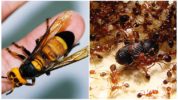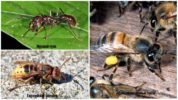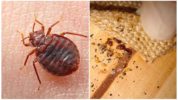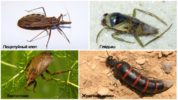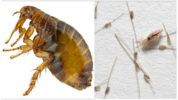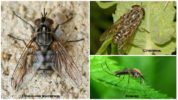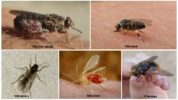- Poisonous insects
- Asian huge hornet
- Fire ants
- Bullet Ant (Paraponera clavata)
- African bees
- European hornet
- Other stinging insects
- Dangerous beetles
- Bed bug
- Kissing bug (Rhodnius prolixus)
- Gladysh (Notonecta glauca)
- Bialystoma
- Navigator bugs
- Fleas
- Lice
- Gnus
- Horsefly
- Mosquito
- Autumn Lighter
- Tsetse fly
- Midge
- Mokrets
- Mosquito
- Gadgets
- Asian huge hornet and fire ants
- Dangerous insects
- Bed bug
- Dangerous beetles
- Flea and head louse
- Gnus
- Dangerous vile
Insects that can cause harm to humans are divided into two categories: poisonous and carriers of dangerous diseases. The first cause people fear of pain and poor health. But the most dangerous insects in the world are not huge wasp hornets, but modest and almost imperceptible representatives of the mean.
Poisonous insects
Many insects use their poison not for attack, but for protection. But this does not negate their danger. A single individual can cause a lot of trouble, but meeting with her is unlikely to lead to death. They become fatal when attacked by a family.
Among the poisonous insects that can kill in an attack in large quantities, the following stand out:
- Asian huge hornets;
- 4 types of fire ants;
- bullet ants;
- Africanized bees;
- European hornets;
- bumblebees;
- wasps;
- the bees.
An interesting feature is that the main purpose of bee stings is to protect the hive from hornets.
Asian huge hornet
A huge wasp from the eastern edge of the Eurasian continent reaches a length of 5 cm. Externally, this terrible insect looks like european hornet 2 times large. Its habitat is East and Southeast Asia. It is also found in the Primorsky Territory in Russia. The feed base of the wasp is other insects. The hornet also attacks its relatives: other wasps and bees. The latter is his favorite dish. Due to food competition asian hornet also kills the European. The latter is found in China.
A single hornet bite is not dangerous for a person without an allergy. Spreading in soft tissues, Asian hornet venom causes swelling and pain for several days, but no more. The attack of several hornets protecting the nest can be fatal for humans.
Interesting!
Asian hornets kill their victims not with a sting, but with powerful jaws.
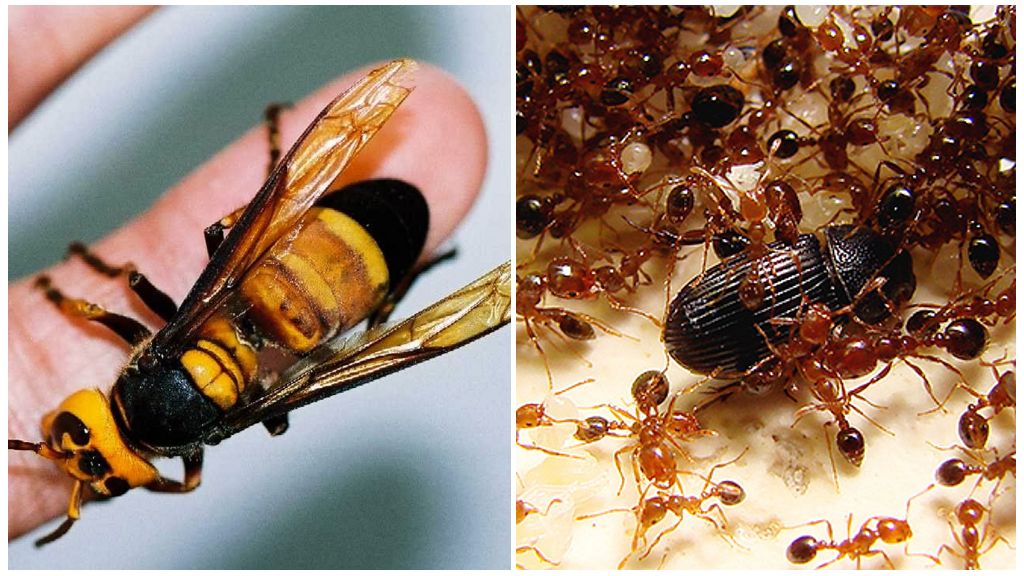
Fire ants
Isolation of the American continents from the rest of the world led to the appearance of the most dangerous insects on the planet. And these insects are the closest relatives of European relatively harmless ants. All 4 species of fire ants hail from the New World. Thanks to man, all of them have already spread to other continents and islands of the planet. In any place today you can meet one of the representatives of these four species:
- black (Solenopsis richteri);
- tropical (Solenopsis geminata);
- southern (Solenopsis xyloni);
- red, red (Solenopsis invicta).
These are small insects, the maximum length of which is not more than 8 mm. The small size does not prevent them from applying burning bites.
On a note!
The adjective “fiery” in the name was given to these species due to the fact that a bite causes burn sensations. The most dangerous in this respect is the red fire ant - the most common species on new continents.
Red fire ants - insects with a body length of 2-3 mm.The color of working females is tan, males are black. They live in underground anthills. The presence of ants can be determined by a mound with a diameter and height of about 0.5 m.
Bullet Ant (Paraponera clavata)
Also an inhabitant of the American continents. Distributed in the tropics of South and Central America. It is one of the most poisonous insects. Schmidt sting scale bullet ant has the highest degree of danger: 4+.
This is a large insect up to 2.5 cm long. The color is brown-black. For anthills this species selects certain types of trees and protects them from pests. For plants, a bullet ant is good. The main part of the food supply is small arthropods and nectar. For an average person, a bullet from a bullet ant is not a fatal bite, although it feels like a gunshot wound. But cases of fatal outcomes were recorded if the victims were allergic to insect venom.
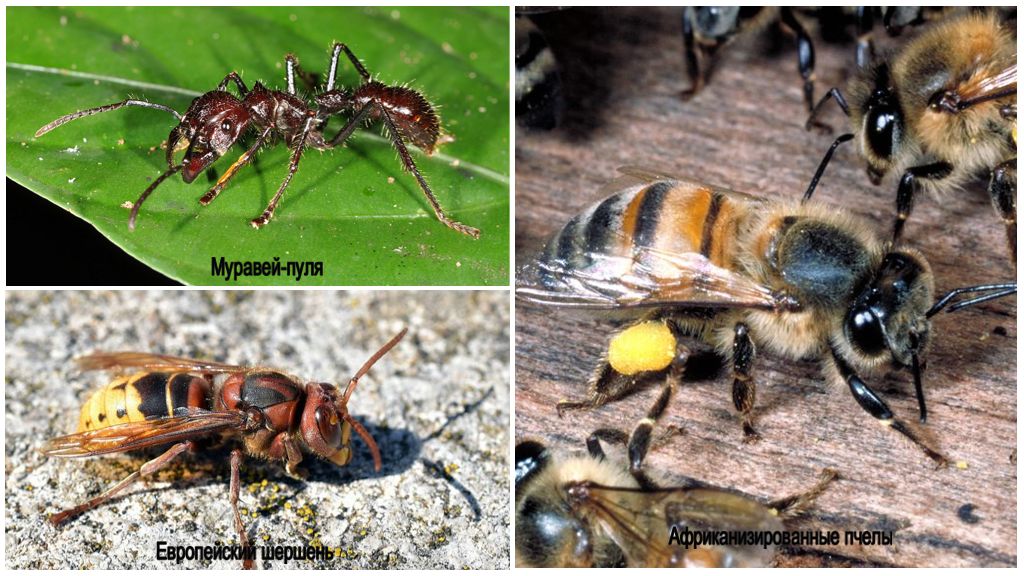
African bees
A good example of what happens when a person inadvertently handles natural species. Africanized bees are a hybrid between African and European honey species. The ancestors of the hybrid are not particularly aggressive or toxic. The offspring turned out to be creepy.
The Africanized bee was first bred in Brazil in 1956. It escaped from the laboratory in 1957 and quickly spread throughout South America. In 1985, she reached North America.
On a note!
The hybrid was called the "killer bee" due to aggressive behavior in protecting the nest. Insects chase a person up to 400 m, causing 10 times more bites than their European and African ancestors. On the account of hybrids, no one counted 1000 deaths among people, horses and other animals. An Africanized bee reasonably ranks among the world's most dangerous insects.
European hornet
He is an ordinary hornet. Large wasp distributed throughout Europe. The eastern border of the range reaches Western Siberia and the Urals. In Asia, the European hornet has a habitat: Kazakhstan, southern Siberia, and eastern China.
The economic role of the hornet is twofold. He hunts pests in the gardens, but can enjoy ripe fruits and berries. Hornet venom causes severe local swelling and soft tissue irritation. But single hornet bite not dangerous for humans. Hornets can create a serious problem only when protecting the nest, when a person gets multiple bites.
Other stinging insects
The bees bumblebees and wasp in terms of toxicity are almost the same. Sting only if disturbed, or when protecting the nests. A single insect is not dangerous for humans. With a large attack, it all depends on the amount of poison received.
Dangerous beetles
Beetles that can cause significant harm to humans include poisonous bugs, bugs and three types of bugs:
- blood-sucking bed bug;
- kiss bug;
- water bug bugs;
- Belostoma.
All bugs have a piercing-sucking type of mouthparts. If the insect does not drink plant juice, but preys on live prey, it can cause a lot of trouble to humans.
Bed bug
This is a synanthropic insect and it preys on humans. Active at night. He has no wings, but is smart enough to climb onto the ceiling and from there fall directly onto the bed. Small insect yellow-brown in a hungry state. Hiding in secluded places during the day. A sign that these insects appeared in the apartment - bite markslocated in a line.
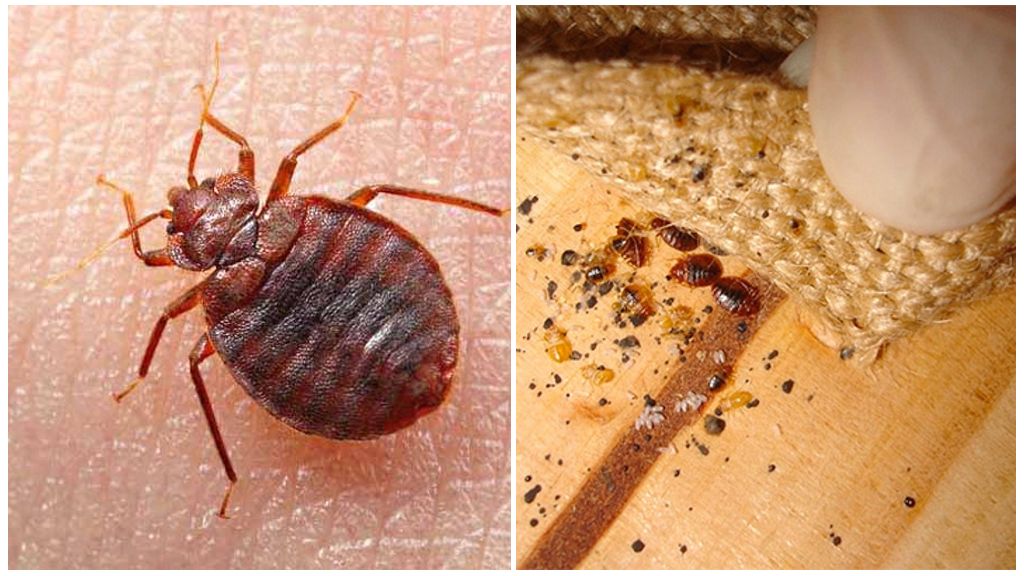
Dangerous bed bug the fact that it can carry pathogens. His bites do not cause special harm if a person does not have allergies. During the mass spread of bugs, these insects even saved from the formation of blood clots. Bedbug venom interferes with blood coagulation, and multiple bites provide a sufficient dose.
Interesting!
The mysterious cadmal insect, which inflicts scary bites, is very likely to be an ordinary bed bug.
There is no reliable data on the cadmal, as well as its photo. There is only a line from a work of art about the author’s stay in an Indian prison. At night in prison, brown insects the size of a thumbtack came out and drank blood. Then the bite sites became inflamed and chased. The latter is a consequence of the Indian climate and unsanitary conditions. But insects by habits and color are very similar to eating bed bugs. The body size of the bug (3-8.4 mm) directly depends on the level of blood saturation.
Kissing bug (Rhodnius prolixus)
Triatomic blood-sucking bug - An inhabitant of South and Central America. Kissed for preference in choosing a bite zone: lip area. Comfortable temperature range 16-28 ° С. Insect flying. Kissing bug is dangerous because it is the main carrier of Chagas disease. This disease is caused by simple microorganisms. A disease can be fatal.
Gladysh (Notonecta glauca)
This water dweller was called a "bug-wasp" for a very painful bite. For a man, he is dangerous only with this pain. Gladys feeds on other aquatic insects and fish fry. Does not tolerate any disease.
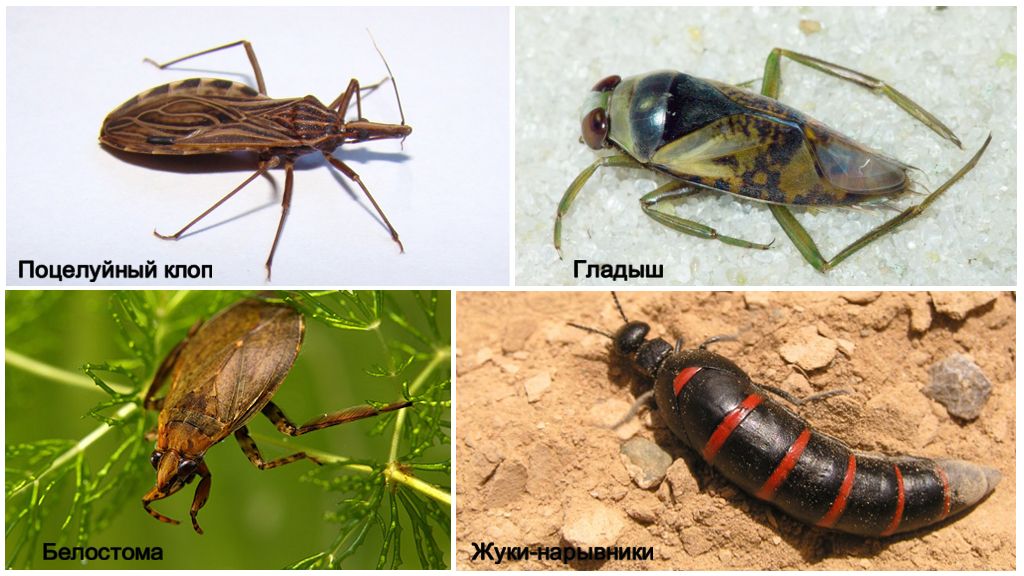
Bialystoma
Giant water bug. The main character of the videos about the new deadly insect. There are about 20 species in the family of the whipstock, but a male Indian water bug, who hatched eggs, was chosen as the monster. The whitefin has an interesting feature - the male takes care of the offspring. A bialystoma bite is very painful, but not dangerous for humans.
Interesting!
To determine which insect has the most painful bite, the same person needs to test both: a bullet ant and a white-breasted.
On the Schmidt scale, there is no whiteostomy, since the bug does not sting, but bites.
Navigator bugs
These poisonous bugs do not bite, but to protect through the pores of the body emit a thick caustic liquid. Plaques they were nicknamed for the fact that necrotic foci and abscesses are formed at the places where liquid enters the skin. Beetles are inhabitants of warm countries. These are parasites for orthoptera invertebrates. Thanks to the boilers, locust control is maintained.
Fleas
Black and well-jumping insects living in the basements of residential buildings, in carpets and on animals. Flea - small insect up to 3 mm in size. The size creates a deceptive feeling that the parasite is not dangerous. Mankind is so used to living next to fleas that it treats them as something very frivolous. But fleas can rightfully be put in the top of dangerous insects.
They are no longer the most dangerous today, but they should not be neglected. These bouncing blood-sucking parasites - The main carriers of the plague in the past. And this disease has not yet been defeated. With the weakening of preventive measures, the plague may flare up again. Natural foci of plague are preserved in the Altai steppes, where several cases of the disease are recorded annually.
On a note!
In addition to the plague, fleas also carry simple parasites and viruses of diseases transmitted through the blood. Tropical sand flea bites into the human body, forming abscesses. This dangerous situation can lead to general blood poisoning.
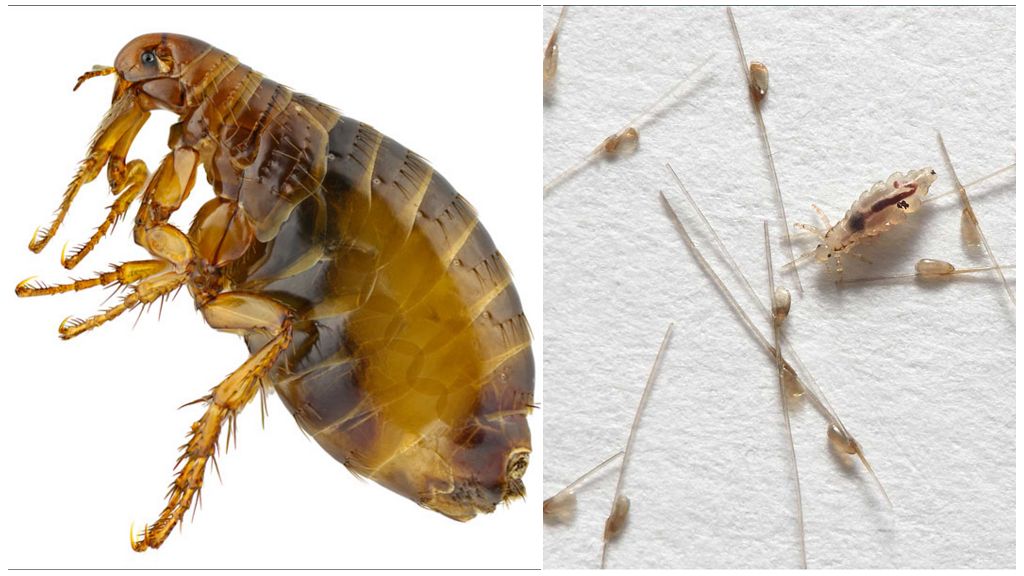
Lice
Small insects with an elongated or short trapezoid (pubic area) body. The hungry louse is gray in color. The body of a translucent and well-fed insect acquires a dark brown color of gore.
Parasites that parasitize humans are not able to drink the blood of other mammals. Due to this, you can not be afraid of the transfer of any "animal" diseases. But lice They are dangerous because they spread typhus and typhoid. In a calm time, this situation seems unthinkable, but the number of lice instantly increases during social upheavals.And then the threat of contracting typhoid ceases to be mythical.
Gnus
This is not a separate insect, but a combination of flies of various species dangerous to humans. All representatives of the gnats belong to the diptera squad:
- horsefly;
- mosquito;
- autumn lighter;
- tsetse fly;
- midge;
- mokret;
- mosquito.
Important!
Blood-sucking insects are dangerous to humans not only because they can carry very dangerous diseases. The cat and the autumn lighter do not pierce the skin, but cut it off, leaving microscopic wounds. If there are a lot of insects, they eat up the skin to meat.
Horsefly
The largest bloodsucking fly is gray. Only females are dangerous horseflies, since males feed on nectar. These large flies are considered one of the most dangerous insects in Central Russia. And it's not about painful bite, and in the amount of dangerous infectious diseases, up to anthrax and tularemia.
Mosquito
A two-winged nocturnal insect, dangerous not because itching "acne" remains after it. Local skin irritation in the absence of allergies is only a cosmetic defect. Mosquitoes dangerous in that they can tolerate a lot of different diseases. In the Middle lane these are the same diseases that can be obtained from horseflies. Further south, malaria, yellow fever, dengue fever and many more are added.
Malaria is transmitted mosquitoes of the genus Anopheles. These are southern insects that do not live in the north of Russia. In the southern regions, malaria was common before draining the swamps. But even today there are sometimes cases of infection with this dangerous disease in the southern regions of the country.
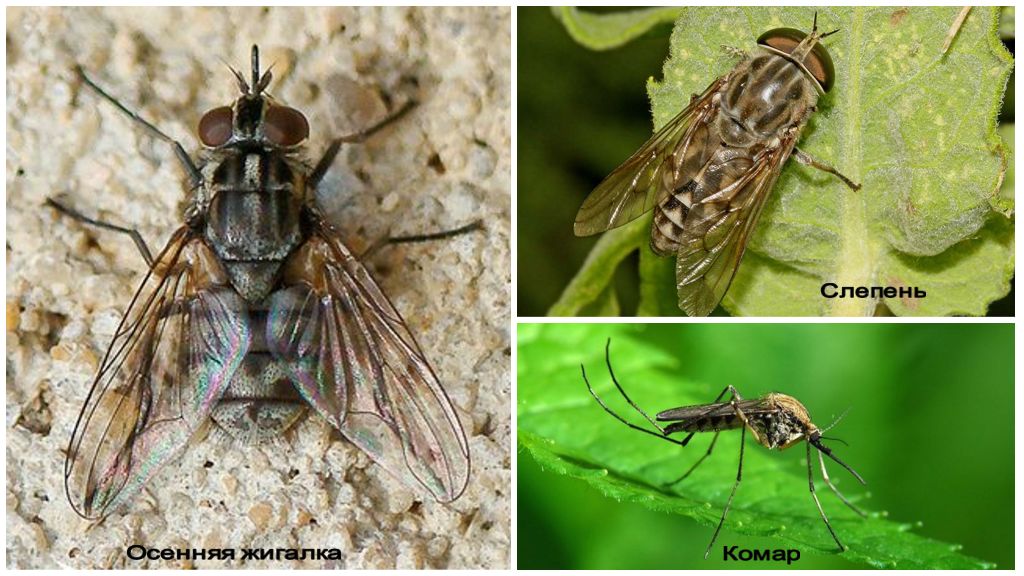
On a note!
The set of poisonous insects in Transylvania, excluding vampires, is the same as everywhere in Europe. But due to climate warming in Romania, Asian tiger mosquitoes appeared and propagated - carriers of West Nile fever, encephalitis and other dangerous infectious diseases.
Autumn Lighter
Small bloodsucker fly. The insect is difficult to distinguish from ordinary house flies until it decides to eat. Zhigalka scrapes the upper layer of the skin and lets saliva with an anticoagulant into the wound. Females need blood to complete the procreation process. The larvae of this synanthropic fly develop in manure. The main time of the adult's life passes there. Lighter is dangerous with the possibility of mechanical transfer of eggs of worms and other invasive parasites on the legs.
Tsetse fly
African endemic dangerous only for tourists and even then not in all areas. It lives in the tropical and subtropical parts of Africa. Carries trypanosomiasis (the famous sleeping sickness and not only it). The reservoir of infection - wild animals that are resistant to the disease. Outwardly, tsetse is similar to ordinary house flies, but differs from them in the manner of folding wings (one on top of the other).
Midge
Two-winged insects, females of which need blood. The size of midges is not more than 2 mm. The color is black. The insect cuts the skin and licks the blood. An allergic reaction to human midge saliva is stronger than mosquito venom. Because of this, the midge can cause dangerous swelling on the face and neck. Sometimes anaphylactic shock occurs. These insects are carriers of parasitic human onchocerciasis and other infectious diseases.
Mokrets
Very small, no more than 4 mm dipterans insects. Bells look like mini mosquitoes. Only females need blood nutrition. Carriers of dangerous infectious diseases:
- Congo-Crimean hemorrhagic fever;
- human filariasis;
- tularemia;
- encephalomyelitis horses.
Saliva causes an allergic reaction.
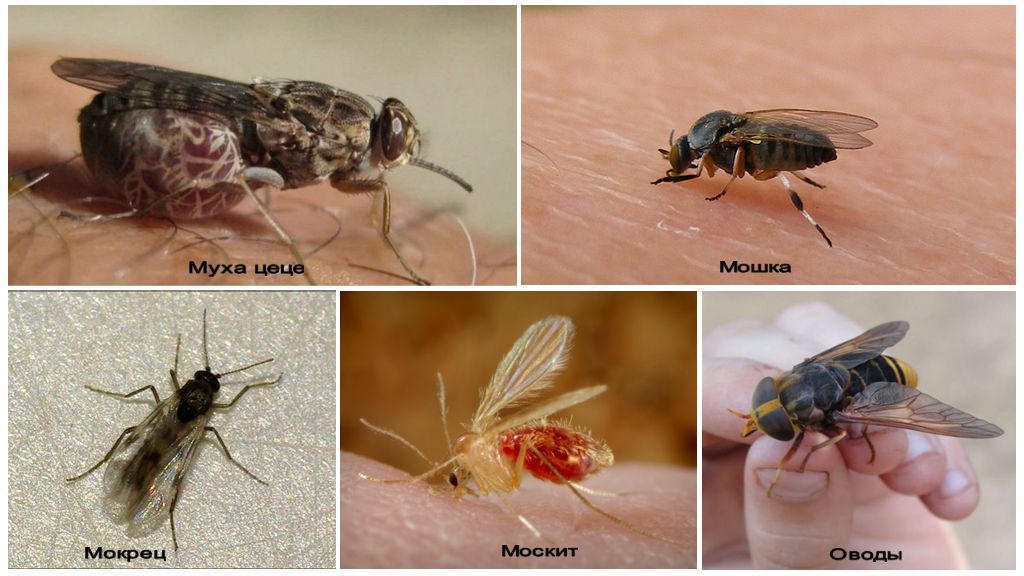
Mosquito
Small "mosquito" with a size of no more than 2.5 mm. Common mosquitoes in tropical areas. Dangerous disease carriers:
- leishmaniasis;
- pappatachi fever;
- bartonellosis.
On a note!
Numerous mosquito bites cause itchy dermatosis. This is a reaction of human tissues to insect saliva. It manifests itself in the form of small itchy nodules of a rash.
Gadgets
Large flies. In a state of imago gadgets don't eat at all.They need mammals to lay eggs. Two types of cavity gadfly are especially dangerous for humans, subcutaneous gadfly rarely uses people as hosts.
Females of Russian and sheep gadflies lay eggs in the eyes and nostrils of animals. Russian prefers donkeys and horses, sheep - goats and sheep. Both species are often used as hosts for people.
Interesting!
Cavity viviparous gadfly. Females inject larvae on the fly. Depending on the place of entry, the larvae either develop in the eyes, or in the nasal and frontal sinuses. With a strong infection of the nasopharyngeal pathways with larvae, animals often die, which is why the sheep gadfly is nicknamed "goat death." Sometimes the adjective is replaced with the word "sheep". In this case, only an operation to remove the larvae from the cavities in the head can save people.
The subcutaneous gadfly lays eggs on the skin, and the emerging larva drills the passages under the skin, moving upward. The larvae of the subcutaneous gadfly are dangerous not only because they cause myiasis, but also because they can sometimes penetrate the brain. This happens due to the instinctive desire of the larva to get to the back of the animal - its natural host. It is more convenient for an adult insect to go free there.
